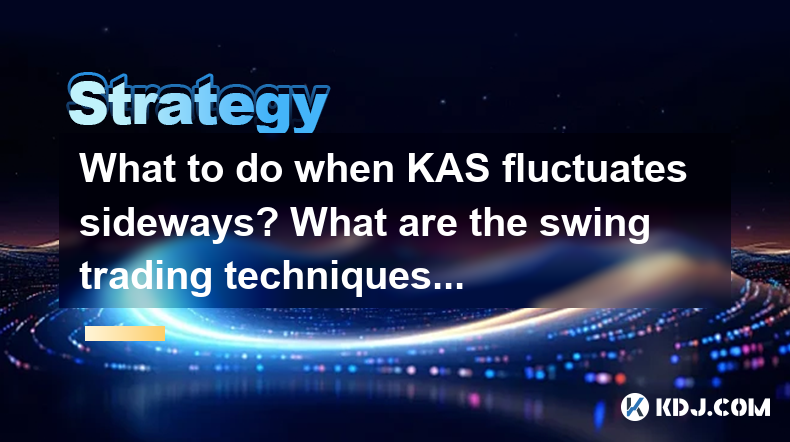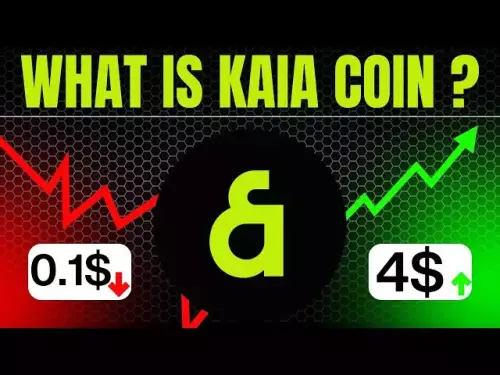-
 bitcoin
bitcoin $112715.707551 USD
-1.71% -
 ethereum
ethereum $4101.475385 USD
-3.01% -
 tether
tether $1.000644 USD
-0.02% -
 bnb
bnb $1207.619465 USD
-6.77% -
 xrp
xrp $2.501451 USD
-3.98% -
 solana
solana $202.947124 USD
-3.32% -
 usd-coin
usd-coin $1.000295 USD
0.04% -
 dogecoin
dogecoin $0.203884 USD
-4.47% -
 tron
tron $0.317154 USD
-1.72% -
 cardano
cardano $0.695009 USD
-4.43% -
 hyperliquid
hyperliquid $38.853961 USD
-8.23% -
 chainlink
chainlink $18.988674 USD
-4.64% -
 ethena-usde
ethena-usde $1.000233 USD
-0.03% -
 stellar
stellar $0.337050 USD
-3.63% -
 bitcoin-cash
bitcoin-cash $536.861728 USD
-1.28%
What to do when KAS fluctuates sideways? What are the swing trading techniques?
When KAS fluctuates sideways, traders can use swing trading to buy near support and sell near resistance, employing technical indicators for better entry and exit points.
Apr 30, 2025 at 05:28 am

When the cryptocurrency Kaspa (KAS) fluctuates sideways, it can present unique opportunities for traders to capitalize on small price movements. Sideways markets, also known as range-bound markets, occur when the price of an asset moves within a relatively stable range without making significant new highs or lows. In such scenarios, swing trading can be an effective strategy to generate profits. This article will explore what to do when KAS fluctuates sideways and delve into the swing trading techniques that can be employed.
Understanding Sideways Markets
Sideways markets are characterized by a lack of clear trend direction. For KAS, this means that the price is oscillating between a defined upper resistance and lower support level. Traders can identify these levels by observing historical price data and noting where the price tends to reverse. Recognizing a sideways market is crucial as it sets the stage for implementing swing trading strategies.
Basics of Swing Trading
Swing trading involves holding positions for a period ranging from a few days to several weeks, aiming to capture gains from price swings within a larger trend or, in this case, within a sideways market. The goal of swing trading in a sideways market is to buy near the support level and sell near the resistance level. This strategy requires patience and a keen eye for market movements.
Identifying Support and Resistance Levels
To effectively swing trade KAS in a sideways market, it's essential to accurately identify the support and resistance levels. Support is the price level at which the market has historically shown a tendency to bounce back up, while resistance is the level at which the market has difficulty breaking through. Traders can use technical analysis tools such as trend lines, moving averages, and historical price data to pinpoint these levels.
- Draw trend lines on a chart to connect the highs and lows of KAS price movements.
- Use moving averages to smooth out price action and identify potential support and resistance zones.
- Analyze historical price data to confirm where the price has consistently reversed in the past.
Entry and Exit Points
Once support and resistance levels are established, the next step is to determine entry and exit points. In a sideways market, the ideal entry point for a long position is near the support level, as this is where the price is likely to start moving upwards. Conversely, the ideal exit point or entry point for a short position is near the resistance level, where the price is likely to start moving downwards.
- Monitor price action closely as it approaches the support level. Look for signs of a potential reversal, such as a bullish candlestick pattern or an increase in buying volume.
- Set a buy order slightly above the support level to ensure you enter the trade if the price bounces back up.
- Monitor price action as it approaches the resistance level. Look for signs of a potential reversal, such as a bearish candlestick pattern or an increase in selling volume.
- Set a sell order slightly below the resistance level to ensure you exit the trade if the price starts to decline.
Risk Management
Effective risk management is crucial when swing trading in a sideways market. Setting stop-loss orders can help limit potential losses if the market moves unexpectedly. A stop-loss order should be placed just below the support level for long positions and just above the resistance level for short positions.
- Determine the appropriate stop-loss level based on your risk tolerance and the volatility of KAS.
- Place a stop-loss order to automatically exit the trade if the price moves against your position.
- Consider using a trailing stop-loss to lock in profits as the price moves in your favor.
Technical Indicators for Swing Trading
Technical indicators can enhance your swing trading strategy by providing additional insights into market conditions. Some commonly used indicators for swing trading KAS in a sideways market include:
- Relative Strength Index (RSI): This momentum oscillator can help identify overbought and oversold conditions. An RSI reading above 70 suggests overbought conditions, while a reading below 30 suggests oversold conditions.
- Moving Average Convergence Divergence (MACD): This trend-following momentum indicator can help identify potential trend reversals. A bullish crossover (when the MACD line crosses above the signal line) can signal a buying opportunity, while a bearish crossover (when the MACD line crosses below the signal line) can signal a selling opportunity.
- Bollinger Bands: These bands can help identify volatility and potential breakouts. When the price is near the lower Bollinger Band, it may be a good time to buy, and when it's near the upper Bollinger Band, it may be a good time to sell.
Practical Example of Swing Trading KAS
Let's consider a practical example of swing trading KAS in a sideways market. Suppose KAS has been trading between a support level of $0.05 and a resistance level of $0.07 for several weeks.
- Identify the support and resistance levels as $0.05 and $0.07, respectively.
- Monitor price action as it approaches the support level of $0.05. If you observe a bullish candlestick pattern or an increase in buying volume, consider entering a long position.
- Set a buy order at $0.051 to ensure you enter the trade if the price bounces back up.
- Monitor price action as it approaches the resistance level of $0.07. If you observe a bearish candlestick pattern or an increase in selling volume, consider exiting the long position or entering a short position.
- Set a sell order at $0.069 to ensure you exit the trade if the price starts to decline.
- Set a stop-loss order at $0.049 for the long position to limit potential losses if the price breaks below the support level.
Frequently Asked Questions
Q: How can I identify if KAS is in a sideways market?A: To identify if KAS is in a sideways market, observe the price action over a period of time. If the price is consistently moving between a defined upper resistance and lower support level without making significant new highs or lows, it is likely in a sideways market. You can use technical analysis tools such as trend lines and moving averages to confirm these levels.
Q: What are the risks associated with swing trading KAS in a sideways market?A: The main risks associated with swing trading KAS in a sideways market include the potential for false breakouts, where the price briefly breaks out of the range before returning, and the risk of the market suddenly trending in one direction, causing significant losses if stop-loss orders are not properly set. Additionally, there is always the risk of market volatility affecting your trades.
Q: Can I use swing trading techniques for other cryptocurrencies besides KAS?A: Yes, swing trading techniques can be applied to other cryptocurrencies as well. The key is to identify the support and resistance levels specific to the cryptocurrency you are trading and apply the same principles of buying near support and selling near resistance.
Q: How important is it to use technical indicators in swing trading KAS?A: Technical indicators can be very useful in swing trading KAS as they provide additional insights into market conditions and potential entry and exit points. However, they should be used in conjunction with other analysis methods and not relied upon solely, as no indicator is foolproof.
Disclaimer:info@kdj.com
The information provided is not trading advice. kdj.com does not assume any responsibility for any investments made based on the information provided in this article. Cryptocurrencies are highly volatile and it is highly recommended that you invest with caution after thorough research!
If you believe that the content used on this website infringes your copyright, please contact us immediately (info@kdj.com) and we will delete it promptly.
- MEXC's Explosive Growth: Trading Volume and Token Gains in Focus
- 2025-10-15 18:25:16
- Pudgy Penguins Price Prediction: Bull Flag Hints at Breakout!
- 2025-10-15 18:45:14
- GateToken Q3 2025 Onchain Destruction: Deflationary Strategy in Action
- 2025-10-15 18:45:14
- Chainlink (LINK): Super Bullish Signals Amidst Institutional Adoption
- 2025-10-15 18:25:16
- Coinbase's India Crypto Play: A Bullish Bet on CoinDCX and the Future of Digital Assets
- 2025-10-15 18:30:01
- Ripple's African Custody Network: A Game Changer?
- 2025-10-15 18:50:01
Related knowledge

Practical parameter settings for a Bitcoin multi-timeframe moving average system
Sep 18,2025 at 10:54pm
Optimizing Timeframe Combinations for Bitcoin Trading1. Selecting appropriate timeframes is crucial when building a multi-timeframe moving average sys...

How can I filter out false breakouts in Dogecoin high-frequency trading?
Sep 22,2025 at 01:00am
Understanding False Breakouts in Dogecoin Trading1. A false breakout occurs when Dogecoin's price appears to move beyond a defined support or resistan...

Techniques for identifying tops and bottoms in the Bitcoin on-chain NVT model
Sep 20,2025 at 07:54pm
Understanding the NVT Model in Bitcoin Analysis1. The Network Value to Transactions (NVT) ratio is often described as the 'P/E ratio' of the cryptocur...

What does the surge in open interest in Bitcoincoin futures mean?
Sep 20,2025 at 11:18pm
Understanding the Surge in Dogecoin Futures Open Interest1. A surge in open interest within Dogecoin futures indicates a growing number of active cont...

How can I use the Ethereum USDT premium to gauge market sentiment?
Sep 18,2025 at 11:55pm
Understanding the Ethereum USDT Premium1. The Ethereum USDT premium refers to the price difference between USDT (Tether) traded on Ethereum-based plat...

What should I do if Ethereum staking yields decline?
Sep 20,2025 at 06:18am
Understanding the Causes Behind Declining Ethereum Staking Yields1. The Ethereum network transitioned to a proof-of-stake consensus mechanism with the...

Practical parameter settings for a Bitcoin multi-timeframe moving average system
Sep 18,2025 at 10:54pm
Optimizing Timeframe Combinations for Bitcoin Trading1. Selecting appropriate timeframes is crucial when building a multi-timeframe moving average sys...

How can I filter out false breakouts in Dogecoin high-frequency trading?
Sep 22,2025 at 01:00am
Understanding False Breakouts in Dogecoin Trading1. A false breakout occurs when Dogecoin's price appears to move beyond a defined support or resistan...

Techniques for identifying tops and bottoms in the Bitcoin on-chain NVT model
Sep 20,2025 at 07:54pm
Understanding the NVT Model in Bitcoin Analysis1. The Network Value to Transactions (NVT) ratio is often described as the 'P/E ratio' of the cryptocur...

What does the surge in open interest in Bitcoincoin futures mean?
Sep 20,2025 at 11:18pm
Understanding the Surge in Dogecoin Futures Open Interest1. A surge in open interest within Dogecoin futures indicates a growing number of active cont...

How can I use the Ethereum USDT premium to gauge market sentiment?
Sep 18,2025 at 11:55pm
Understanding the Ethereum USDT Premium1. The Ethereum USDT premium refers to the price difference between USDT (Tether) traded on Ethereum-based plat...

What should I do if Ethereum staking yields decline?
Sep 20,2025 at 06:18am
Understanding the Causes Behind Declining Ethereum Staking Yields1. The Ethereum network transitioned to a proof-of-stake consensus mechanism with the...
See all articles


























![Staking ATH: How To Stake $ATH in October 2025 with 523% APY — [Step-By-Step Guide] Staking ATH: How To Stake $ATH in October 2025 with 523% APY — [Step-By-Step Guide]](/uploads/2025/10/15/cryptocurrencies-news/videos/staking-ath-stake-ath-october-apy-stepstep-guide/68eef94d80903_image_500_375.webp)















































